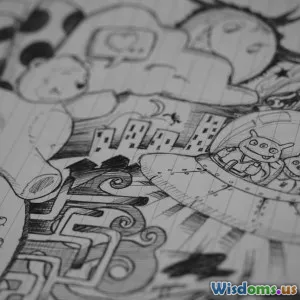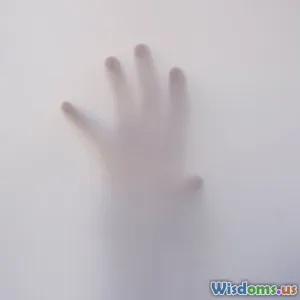
Remote Viewing What It Is and Why Governments Invested Millions
7 min read Explore the intriguing world of remote viewing and uncover why governments funneled millions into this mysterious psychic phenomenon. (0 Reviews)
Remote Viewing: What It Is and Why Governments Invested Millions
Imagine glimpsing a distant location or event without leaving your room—no cameras, no satellites, just pure mind power. This is remote viewing, a practice that sounds like science fiction but intrigued intelligence agencies so deeply that it warranted multimillion-dollar funding. What is remote viewing? How did it catch the attention of governments, and what have been the outcomes of such secretive endeavors?
Introduction: The Allure of Seeing the Unseen
Remote viewing refers to the claimed psychic ability to perceive or describe details of distant or unseen targets using only the mind. It gained ground in the late 20th century as researchers and intelligence agencies explored the boundaries of human potential in espionage and surveillance.
The idea tantalizes the imagination: Could human consciousness tap into the universal pool of information, bypassing physical limits? During the Cold War, with stakes high and technology not yet perfected, some governments funded extensive projects to explore this very question, hoping remote viewing could provide an unforeseeable edge.
Understanding Remote Viewing
Origins and Definition
Remote viewing emerged from parapsychological research in the 1970s. It was initially coined and refined by physicists and researchers targeting controlled psychic phenomena. In essence, remote viewing attempts to describe or list impressions about a distant or unseen target, which could be a place, person, object, or activity.
Unlike clairvoyance or telepathy, remote viewing emphasizes a structured methodology — viewers follow protocols to avoid guesswork or influence by conscious reasoning.
Methodology and Practice
Remote viewers typically work blind to the target’s identity. They receive coordinates or vague cues and are asked to describe impressions like shapes, colors, emotions, or sounds. Often, sessions are scored based on accuracy against the actual target.
Experts in remote viewing might undergo rigorous training to enhance focus and mental discipline. The process also leverages concepts like relaxation, meditation, and sometimes altered states of consciousness to access purported psychic information.
Why Governments Invested Millions
The Cold War Context
During the height of the Cold War, intelligence superiority was paramount. Conventional surveillance and spying had their limits and risks; thus, unorthodox approaches seized attention. Remote viewing promised the ability to gather intelligence without physical deployment or technological infrastructure.
The Stargate Project: A Governmental Case Study
Perhaps the most famous program was the US Army's Stargate Project. Initiated in the 1970s and later absorbed by the CIA, the project sought to investigate psychic spying.
Over approximately two decades, the government funneled an estimated $20 million into remote viewing research and applications, including reports on foreign military bases and secret weapons.
Notable Achievements
- Remote viewers reportedly provided valuable intelligence during the Iran Hostage Crisis, identifying the location of hostages in Tehran.
- Others claimed success in locating downed Soviet bombers or secret missile sites.
While many successes remain classified or disputed, government evaluations yielded mixed results. In 1995, a CIA report concluded that remote viewing had limited operational value, leading to project termination but leaving an enduring legacy and controversy.
Other Government Programs
The Soviet Union also invested heavily in psychic research, conducting experiments with so-called "psychotronics." Evidence suggests that competing intelligence agencies explored similar avenues, fueling a psychic arms race beyond open science.
Skepticism and Scientific Scrutiny
Critical Perspectives
Skeptics argue that remote viewing lacks empirical support and that many successes failed rigorous replication. Critics emphasize cognitive biases, chance, and subjective interpretations often involved in remote viewing data.
Noted scientists like Ray Hyman reviewed reports extensively and highlighted issues like non-blinding and methodological flaws in research designs.
Scientific Research Endeavors
Nonetheless, significant experiments by researchers such as Russell Targ and Harold Puthoff attempted controlled investigation at institutions like SRI International, producing intriguing but inconclusive results. The field remains controversial yet compelling within parapsychology.
The Cultural and Psychological Impact
Beyond espionage, remote viewing influenced popular culture, inspiring movies, books, and interest in human consciousness expansion. The persistence of such phenomena underlines humanity's curiosity about hidden capabilities.
Moreover, the programs demonstrate how fear, competition, and ambition drive governments to explore unconventional frontiers, sometimes blurring the lines between science and mysticism.
Conclusion: The Legacy of Remote Viewing
Remote viewing remains one of the most enigmatic psychic phenomena ever seriously tested by governments. Though officially discontinued, public fascination persists, fueled by declassified documents and anecdotal tales.
Whether seen as a genuine but elusive ability or an elaborate Cold War curiosity, remote viewing's story reveals a profound desire to transcend physical limits and acquire knowledge in mysterious ways.
While science demands rigorous proof and skepticism rightly guards truth, the millions invested reflect the enduring quest to unlock the mind’s untapped potential. For modern readers, it’s an invitation to explore the intersection of psychology, espionage, and the paranormal — a unique chapter in humanity’s search for the unknown.
References & Further Reading:
- Institute of Noetic Sciences – Research on Consciousness
- CIA Freedom of Information Act Electronic Reading Room: Stargate Project files
- "Psychic Warfare" by Joseph McMoneagle
- Skeptical Inquirer articles on remote viewing
This article aims to shed light on a fascinating blend of espionage history and parapsychology, inviting you to critically consider the possibilities alongside the facts.
Rate the Post
User Reviews
Popular Posts



















